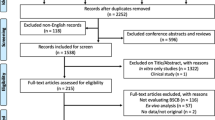Abstract
Purpose
The goal of this study was to determine whether molecular imaging of retrograde axonal transport is a suitable technique to detect changes in the spinal cord in response to radiation injury.
Procedures
The lower thoracic spinal cords of adult female BALB/c mice were irradiated with single doses of 2, 10, or 80 Gy. An optical imaging method was used to observe the migration of the fluorescently labeled nontoxic C-fragment of tetanus toxin (TTc) from an injection site in the calf muscles to the spinal cord. Changes in migration patterns compared with baseline and controls allowed assessment of radiation-induced alterations in the retrograde neuronal axonal transport mechanism. Subsequently, tissues were harvested and histological examination of the spinal cords performed.
Results
Transport of TTc in the thoracic spinal cord was impaired in a dose-dependent manner. Transport was significantly decreased by 16 days in animals exposed to either 10 or 80 Gy, while animals exposed to 2 Gy were affected only minimally. Further, animals exposed to the highest dose also experienced significant weight loss by 9 days and developed posterior paralysis by 45 days. Marked histological changes including vacuolization, and white matter necrosis were observed in radiated cords after 30 days for mice exposed to 80 Gy.
Conclusion
Radiation of the spinal cord induces dose-dependent changes in retrograde axonal transport, which can be monitored by molecular imaging. This approach suggests a novel diagnostic modality to assess nerve injury and monitor therapeutic interventions.





Similar content being viewed by others
References
Atkinson S, Li YQ, Wong CS (2003) Changes in oligodendrocytes and myelin gene expression after radiation in the rodent spinal cord. Int J Radiat Oncol Biol Phys 57:1093–1100
Dropcho EJ (2010) Neurotoxicity of radiation therapy. Neurol Clin 28:217–234
Garg AK, Shiu AS, Yang J et al (2012) Phase 1/2 trial of single-session stereotactic body radiotherapy for previously unirradiated spinal metastases. Cancer 118:5069–5077
Medin PM, Boike TP (2011) Spinal cord tolerance in the age of spinal radiosurgery: lessons from preclinical studies. Int J Radiat Oncol Biol Phys 79:1302–1309
Medin PM, Foster RD, van der Kogel AJ et al (2012) Spinal cord tolerance to reirradiation with single-fraction radiosurgery: a swine model. Int J Radiat Oncol Biol Phys 83:1031–1037
Medin PM, Foster RD, van der Kogel AJ, Sayre JW et al (2011) Spinal cord tolerance to single-fraction partial-volume irradiation: a swine model. Int J Radiat Oncol Biol Phys 79:226–232
Levi-Montalcini R, Hamburger V (1951) Selective growth stimulating effects of mouse sarcoma on the sensory and sympathetic nervous system of the chick embryo. J Exp Zool 116:321–361
Helting TB, Zwisler O (1977) Structure of tetanus toxin. I. Breakdown of the toxin molecule and discrimination between polypeptide fragments. J Biol Chem 252:187–193
Helting TB, Zwisler O, Wiegandt H (1977) Structure of tetanus toxin. II. Toxin binding to ganglioside. J Biol Chem 252:194–198
Schellingerhout D, Le Roux LG, Bredow S, Gelovani JG (2009) Fluorescence imaging of fast retrograde axonal transport in living animals. Mol Imaging 8:319–329
Schellingerhout D, LeRoux LG, Hobbs BP, Bredow S (2012) Impairment of retrograde neuronal transport in oxaliplatin-induced neuropathy demonstrated by molecular imaging. PLoS One 7:e45776
Carson F, Hladil C (2009) Histotechnology: a self-instructional text. American Society for Clinical Pathology, Hong Kong
Sahgal A, Ma L, Gibbs I et al (2010) Spinal cord tolerance for stereotactic body radiotherapy. Int J Radiat Oncol Biol Phys 77:548–553
Okada S, Okeda R (2001) Pathology of radiation myelopathy. Neuropathology 21:247–265
Lo YC, McBride WH, Withers HR (1992) The effect of single doses of radiation on mouse spinal cord. Int J Radiat Oncol Biol Phys 22:57–63
Bijl HP, van Luijk P, Coppes RP et al (2002) Dose-volume effects in the rat cervical spinal cord after proton irradiation. Int J Radiat Oncol Biol Phys 52:205–211
Medin PM, Foster RD, van der Kogel AJ et al (2011) Spinal cord tolerance to single-fraction partial-volume irradiation: a swine model. Int J Radiat Oncol Biol Phys 79:226–232
Pan H, Simpson DR, Mell LK et al (2011) A survey of stereotactic body radiotherapy use in the United States. Cancer 117:4566–4572
Sahgal A, Weinberg V, Ma L et al (2012) Probabilities of radiation myelopathy specific to stereotactic body radiation therapy to guide safe practice. Int J Radiat Oncol Biol Phys 71:652–665
Schoemaker JH (1994) Impaired axonal transport in diabetic neuropathy. Diabetes Care 17:1362
Green LS, Donoso JA, Heller-Bettinger IE, Samson FE (1977) Axonal transport disturbances in vincristine-induced peripheral neuropathy. Ann Neurol 1:255–262
Lapointe NE, Morfini G, Brady ST et al (2013) Effects of eribulin, vincristine, paclitaxel and ixabepilone on fast axonal transport and kinesin-1 driven microtubule gliding: implications for chemotherapy-induced peripheral neuropathy. Neurotoxicology 37:231–239
Nagata H, Ohkoshi N, Kanazawa I et al (1992) Rapid axonal transport velocity is reduced in experimental ethylene oxide neuropathy. Mol Chem Neuropathol 17:209–217
Wakabayashi M, Araki K, Takahashi Y (1976) Increased rate of fast axonal transport in methylmercury-induced neuropathy. Brain Res 117:524–528
Holzbaur EL, Scherer SS (2011) Microtubules, axonal transport, and neuropathy. N Engl J Med 365:2330–2332
Boyette-Davis J, Dougherty PM (2011) Protection against oxaliplatin-induced mechanical hyperalgesia and intraepidermal nerve fiber loss by minocycline. Exp Neurol 229:353–357
Acknowledgments
We would like to thank Dr. Daniel Young for assisting us with the embedding and sectioning of animal material.
Conflict of Interest
The authors declare no potential conflicts of interest.
Funding Sources
The support of the Mike Hogg Award, the M D Anderson Cancer Center Institutional Research Grant, the National Institute for Neurological Disorders and Stroke R01NS070742-01A1, and The John S. Dunn, Sr. Distinguished Chair in Diagnostic Imaging is gratefully acknowledged. The sponsors had no role in study design, research execution, analysis, or decision to publish.
Author information
Authors and Affiliations
Corresponding author
Additional information
Lucia G. LeRoux and Sebastian Bredow contributed equally
Rights and permissions
About this article
Cite this article
LeRoux, L.G., Bredow, S., Grosshans, D. et al. Molecular Imaging Detects Impairment in the Retrograde Axonal Transport Mechanism After Radiation-Induced Spinal Cord Injury. Mol Imaging Biol 16, 504–510 (2014). https://doi.org/10.1007/s11307-013-0713-0
Published:
Issue Date:
DOI: https://doi.org/10.1007/s11307-013-0713-0




